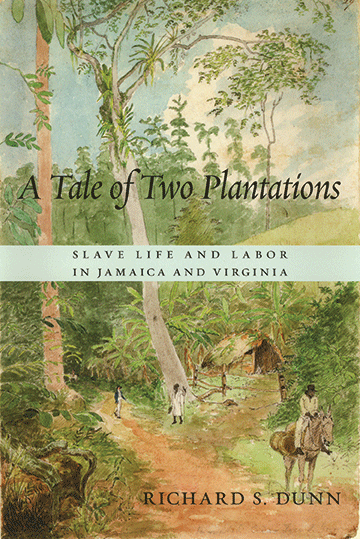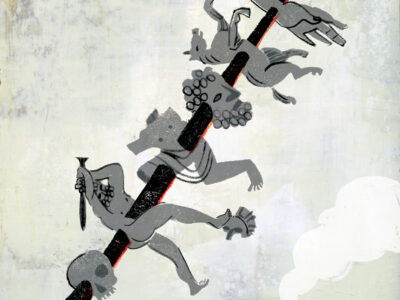A 40-year examination of two slave societies sheds new light on a bleak subject.

A TALE OF TWO PLANTATIONS: Slave Life and Labor in Jamaica and Virginia; By Richard S. Dunn, faculty; Harvard University Press, 540 pages, $39.95.
By Julia M. Klein | Richard Dunn’s comparative study of two slave societies is the sort of book destined to become legendary—for the scope of its ambition and the labor involved as much as for its considerable achievements.
Dunn, the Roy F. and Jeannette P. Nichols Professor Emeritus of American History and founding director of the University’s McNeil Center for Early American Studies, admits to having worked on A Tale of Two Plantations intermittently for 40 years—a biblical time span. His example, he notes with wry understatement, “is not a recommended modus operandi for historians.
“This long gestation period,” he adds in the book’s prologue, “reflects the difficulty in bringing to life some very hidden people, in articulating the experiences of two quite different communities of slaves, and in situating [these two communities] within a meaningful larger framework.”
The enslaved populations of Virginia’s Mount Airy plantation and Jamaica’s Mesopotamia are the focus of Dunn’s inquiry. He researched three generations at each site, concluding with each society’s transition to freedom (1834-44 in Jamaica and 1865-70 in the American South). His subjects have been hidden for obvious reasons: Most lacked both the literacy and the leisure to produce written accounts of their servitude.
As Dunn notes, our existing slave narratives derive mostly from exceptional cases. (The fugitive slave turned abolitionist orator Frederick Douglass and the kidnapped freeman Solomon Northup come immediately to mind.) Documenting the lives of more typical field hands, artisans, and domestic workers is a different matter, requiring a feat of historical reconstruction and imagination.
Among recent achievements of this type, one thinks of Annette Gordon-Reed’s Pulitzer Prize- and National Book Award-winning book,The Hemingses of Monticello: An American Family (2008). Because of their blood ties to Thomas Jefferson, the Hemingses were, in a sense, sui generis—but their story also shed light on how interracial relationships affected slave work, manumission, and crossing the color line. Gordon-Reed, in the absence of documentation, sometimes let her imagination soar.
By contrast, Dunn, while tracing dozens of slave families, rarely strays from the evidence. The result is less exhilarating than The Hemingses, but more impeccable in its historical rigor.
Dunn relies on troves of archival documents that are at once voluminous and sketchy: plantation records, including slave inventories and work logs; the correspondence of slave owners (the Tayloes of Virginia and the Barhams of Jamaica); and the diaries of the Moravian missionaries who sought to Christianize slaves at Mesopotamia.
Of particular interest is the diary of a Jamaican slave-owner from a nearby plantation, Thomas Thistlewood, who was horrifically violent, frequently having his way with his female slaves, and meticulous in describing his excesses. Difficult as it is to read about the revolting punishments he administered, his diary adds arresting detail to Dunn’s study. Interracial sex, evidenced by mixed-race children who often took their fathers’ names, was not unusual in Jamaica. Nor was it unknown, of course, in Virginia, though it tended to involve greater secrecy. Thistlewood, by contrast, reveled in his licentiousness, recording each assignation.
Dunn draws sharp demographic and social distinctions between Mount Airy and Mesopotamia, and argues that they were reflective of the two slave systems as a whole. “[S]lavery caused terrible suffering to the black people of both regions,” he writes, “but in strikingly dissimilar ways.”
The work regime and punishments were harsher at Mesopotamia, where field slaves, grouped by ability, labored in gangs to cultivate and harvest sugar cane. Disease and industrial accidents were common. Slaves had little time to grow their own food, were often hungry, and sometimes resorted to theft to avert “semistarvation.” As a result, slaves at Mesopotamia had fewer children and died in larger numbers than in Virginia. The shrinking work force had to be continually replenished from Africa, or from other plantations, ensuring considerable cultural mixing.
Life and work weren’t easy at Mount Airy, where field hands first grew tobacco, then wheat and corn. (Craftspeople and domestic workers, as at Mesopotamia, had a better time of it.) But the Tayloes were not particularly brutal, on occasion even admonishing or dismissing an overseer for cruelty. And hunger was not an issue.
Unlike the absentee Barhams, who lived in England and relied on attorneys, overseers, and accountants to squeeze profits from Jamaican sugar cane, the Tayloes resided at Mount Airy and their other plantations, and knew the people they owned. That made a difference.
But it did not mitigate the greatest hazard facing Mount Airy slaves: As their numbers grew, the Tayloes had more workers than they needed. So they would periodically sell off slaves, even if that meant breaking up families. Beginning in 1833, they also sent workers from Virginia to Tayloe-owned cotton plantations in Alabama. Clearing land for cotton was especially hard labor, and some slaves tried running away. Others were sold. On a more human note, the Tayloe letters sometimes conveyed regards from their newly settled Alabama slaves to their loved ones in Virginia. And the end of the Civil War fostered many reunions of divided families.
One of the most intriguing aspects of A Tale of Two Plantations is its account of the relationship between the Moravian missionaries and the Mesopotamia slaves. Because the Moravians, unlike some other Christian denominations, preached submission, the Barhams financed their mission. To the slaves, the Moravians at least represented white people who did not whip, starve, or sexually exploit them. One oddity of Moravian evangelism was how reluctant the missionaries were to allow baptisms, meting them out only by lot—unless, it seems, a prospective convert was about to die.
To read A Tale of Two Plantations is to plunge, by way of dry, dusty registers and long lists of names, into the dirt-hard particulars of slave life. It is difficult to find even a glimmer of hope or happiness in these stories. Dunn does highlight the modest triumphs of a “quadroon” named Jane Ritchie, born in 1814 at Mesopotamia. Jane successfully pitted the Moravian missionaries, whom she disliked, against other plantation whites; she also “married a freed mulatto, shared a bed (at least temporarily) with the white overseer, and secured her emancipation ahead of time.” But Dunn, as always, is careful to put her achievement in context, calling her “the sole person I have found among the 1,103 slaves living on this estate between 1762 and 1833 who outmaneuvered her white masters in a major way.”




